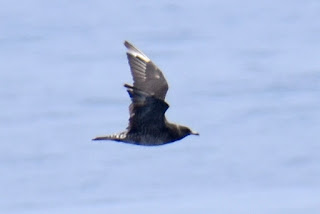24 Hour Cape May Pelagic, 6/18-6/19- Skua, Jaeger, Beaked Whales, Devil Ray, Hammerhead Sharks and more
Just a few days after returning from a Bahamas cruise, I headed down to Cape May for a 24-hour pelagic trip aboard the American Star. We left the dock at nine in the evening to make our way out about 90 miles offshore. After about an hour I decided to turn in for the rest of the night. The boat is set up for daytime whale and dolphin watching tours, so there are no real sleeping quarters on board. I enveloped myself in a sleeping bag on a metal bench on the upper deck. The bench was only as wide as me, so it was not a comfortable night. The sea conditions were not bad, but I catnapped through the night ride trying not to roll off the bench. Around five o’clock, daylight started to break up the night sky and people began emerging from their makeshift beds. I’m sure those who brought beanbag cushions slept much better than I did. Either way I survived the night and the day ahead turned out to be well worth the ride. We saw the expected pelagic birds for this season, plus a few surprise birds as well, and the marine wildlife did not disappoint either. For the trip I added five species to my New Jersey bird list and saw four new marine animals.
As usual, storm-petrels were the first birds to appear. Wilson’s Storm-petrels were the most familiar and most encountered. Not long afterwards we began to see longer winged storm-petrels mixing in with the Wilson’s. Band-rumped and Leach’s Storm-petrels finally made my NJ list. Cory’s Shearwaters, the world’s largest shearwaters, were the first of the larger tubenose birds to appear. Shortly after 7 a.m. a black and white seabird was seen in the distance and was quickly identified as a Black-capped Petrel. It was the only one we saw, and my third new state bird of the day. Great Shearwaters began showing after the 9 o’clock hour. Leach’s and band-rumped storm petrel sightings continued well past the 10 o’clock hour, and Wilson’s storm-petrels, Cory’s and great shearwaters continued throughout most of the day.
A rare sight in NJ, two Leach's storm-petrels together. © S. Weiss
Left, Cory's shearwater. Right, great shearwater. © S. Weiss
Shortly after 12 noon, after not seeing a different bird for a few hours, I mentioned to my friend Jason that it would be nice to see a Pomarine Jaeger. Less than ten seconds later someone shouted, “Jaeger!” A pomarine jaeger was flying down the starboard side of the boat. Just like that, I had my fourth new state bird of the day. About an hour later, a nice surprise bird was seen sitting on the water, a Dovekie. A dovekie in NJ in June is rare as their breeding range is well north in the Arctic. New bird sightings had fallen into a lull after the dovekie. Just after 4 o’clock Jason broke the drought when he shouted, “Skua!” He had spotted a South Polar Skua off in the distance. The bird did not disappoint anybody. As these skuas tend to do, it turned and headed towards us to check out the boat. It gave great views as it passed by the bow before turning and disappearing back towards the horizon. It was my fifth and last state bird of the day.
Left, pomarine jaeger. Right, south polar skua. © S. Weiss
In between the birds we were treated to some incredible marine life sightings. We saw four different cetacean species. Three of them were dolphins: Pelagic Bottlenose Dolphins, Costal Bottlenose Dolphins and Risso’s Dolphins. The Risso’s dolphins look much different than their more familiar bottlenose cousins. They are usually found at the edge of the continental shelf. The fourth cetacean species was Sowerby’s Beaked Whales.
Risso's dolphins. © S. Weiss
A Risso's dolphin has a bulbous head and a blunt snout, instead of a beak like a bottlenose dolphin. They usually are recognizable from the heavy scarring about their bodies. Scarring comes from their interactions with each other, and also possibly from squids for which they dive deep to catch.
The back of a Sowerby's beaked whale. © S. Weiss
Beaked whales are deep divers. They have long beaks and look like a cross between a dolphin and a whale. There are six beaked whale species residing in the Atlantic Ocean and encounters with them are not common. Species identification is usually done by the location of the males’ erupted teeth (or tusks) along the beak. In most species, only adult males have teeth and only one pair on the lower jaw.
Left, three hammerhead sharks. Right, common mola. © S. Weiss
Sicklefin, or Chilean, devil ray. © S. Weiss
The sicklefin devil ray is an endangered tropical species. It has only recently been documented in the eastern United States.
The Risso’s dolphins, Sowerby’s beaked whales, sicklefin devil ray and loggerhead sea turtles were all new species for me. Five new state birds and four new marine species for the day more than made up for the sleep-deprived night before.

















Comments
Post a Comment